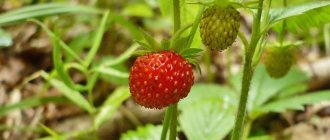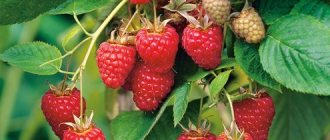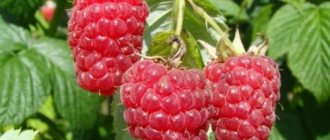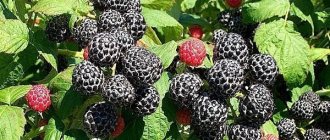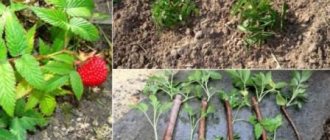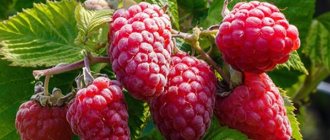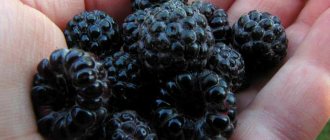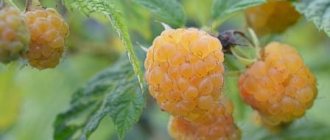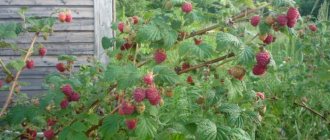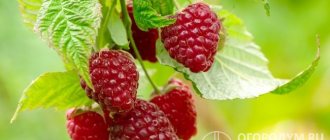Description of black raspberry
Black raspberries got their name due to the specific inky hue of the fruit. The bushes are very lush and have large dark berries. A distinctive feature of this variety is its high-quality and tasty harvest, obtained in large volumes, which is what distinguishes it from the usual red and white raspberry varieties. This is a perennial bush, the shoots of which can be from 1 to 3 m in height.
Culture has certain characteristics:
- Strong roots that do not form unnecessary shoots. Therefore, you can plant individual bushes nearby with other plants, and not worry that they may be destroyed.
- The bush bears fruit early and is highly resistant to dry periods. Raspberries can be located in sunny and open areas. Will not dry out in hot summers.
- The berries hold tightly enough, therefore, even after full ripening, the fruits will not fall to the ground if they are not collected in time.
- It is highly resistant to various types of diseases and is extremely rarely attacked by insects.
- No complex or special care required. It is enough to periodically perform simple fertilizing and moderate watering. But not all types of chokeberries can easily tolerate severe cold. Before winter, it is recommended to tie the bushes, otherwise thin shoots may break under the weight of snow.
- Flowering begins no earlier than in the second year of plant growth. The flowers are quite large, in the form of large racemes. Each flower has 5 white petals, as well as green sepals. A distinctive feature of flowers is the presence of a large number of stamens.
- The petals are oblong, the sepals are triangular.
- Flowering begins in late spring or early summer (this is influenced by the time when the plant was planted). Flowering duration is about 14 days.
Pruning and preparation for winter
If you need raspberries that are easy to care for and extremely frost-resistant, the Cumberland variety is the most suitable option. But caring for it is still required if you want to get more. One of the most important points that affects the yield of berries is double pruning. What is its essence? It consists of two stages:
- Shortening shoots at the end of June. Why is this being done? The fact is that the plant has very high vegetative power and bears fruit on one-year shoots, which are placed on two-year branches. In order to have more such branches, it is necessary to cut off the growing point during the period of the fastest development of the plant. The stem begins to throw additional branches to the sides, forming a “fan”. Next year there will be many one-year-old branches on this fan, and the yield will increase several times.
- The second pruning is carried out as always in the fall. Everything is done in the same way as usual caring for a traditional “red” variety: shoots are shortened, old, dry ones are cut out, shoots are cut out, etc.
As for preparing for winter, one of the hardiest plants is the black raspberry, care for which simply involves pruning, wrapping with agrofibre or bending to the ground. The stems are tied into bunches, a weight is tied, laid on the ground - the plant is ready to face the harsh Russian frosts.
Some gardeners use the “vertical” mating method. A wooden holder is hammered into the center of the bush, as when cultivating currant bushes, and all the stems are tied to it and wrapped in agrofibre, burlap or other material that will protect against icing. This is quite enough to survive even a snowless winter. If at least 5-10 centimeters of snow falls and it covers the ground, then there are no problems with wintering at all. Black raspberries, varieties of which tolerate cold well, will quickly move away from wintering, sprout new shoots and produce a lot of fruits.
If you follow all the above recommendations for care and cultivation, then you will have large, productive raspberries - the Cumberland variety will delight you with black, fragrant berries! They are suitable for making jam, making juice, eating fresh, and for decorating cakes and sweets. Add exoticism to your garden!
Difference from blackberries and red raspberries
The main distinguishing features, when compared with red raspberries and blackberries, are:
- Fruit. Hollow inner part. It is easily torn off, the receptacle remains hanging on the branch. The blackberry will remain empty; both the fruit and the receptacle will break off at the same time. Chokeberry raspberries have a hemispherical shape, which makes them different from regular red raspberries.
- Maturation period. There are also differences in ripening time, since blackberries ripen much later. There are species that have the same harvest period.
- Appearance. If you carefully examine the plants, you will notice differences in the stems. Blackberries have long green stems and strong thorns. Blackberries have a very dense bush and can resemble coiled wire. The branches of black raspberries are shorter and thinner, unlike the classic red ones.
Dark berries have a sweeter taste and are juicy. During the summer, harvesting approximately 4 kg of ripe fruits from one bush. The berries are not only very large, but also quite elastic, so they do not wrinkle during transportation. Aronia raspberries contain many valuable acids and a lot of vitamins.
Black raspberries make incredibly delicious jams and preserves. This delicacy is very tasty and makes an excellent vitamin supplement for tea.
Description
Chokeberry raspberry is a perennial shrub. In the first year of life, active growth of vertical shoots occurs.
From the second year, lateral shoots appear on the stems and vertical shoots take on a cascading shape. Dense clusters of buds are formed at the ends of the short lateral processes. Flowers and berries are formed only on shoots of the second year of life.
The stems of black raspberries are initially green with a bluish tint. The next year lignification occurs and they turn brown. Each of them is covered with curved short spines.
On a note! Black raspberries do not form root shoots.
The leaves are five-lobed, oval, finely toothed at the edges. The upper part of the leaf blade is pubescent, the lower part is covered with short whitish hairs.
The flowers are white, consist of 5 elliptical petals, 5 triangular sepals and many stamens.
The berries are first white, then red and become black-purple when ripe. The fruits are fleshy, sweet, slightly tart. They separate well from the stalk.
Characteristics of berries in the table:
| Color | Dark purple, with a waxy coating |
| Size | 18-22 mm in diameter |
| Weight | 2.2 g |
| Taste | Sweet, slightly tart |
| Transportability | good |
Gardeners include the following as the main advantages of black raspberries:
- High yield - on average from 2 to 4 kg per bush.
- Sweeter taste of the berries compared to red raspberries.
- The elasticity of the fruits - they do not deform during transportation.
Black raspberries are unpretentious crops and take root well almost anywhere. Growing and care are not difficult even for novice gardeners
To obtain large harvests, it is necessary to choose the right place for planting, prepare the soil and healthy seedlings. Read more about how to plant and care.
Varieties and their characteristics
There are a large number of varieties of black raspberries. When choosing a particular species for the garden, you need to take into account the ripening time, characteristics, fruiting characteristics and taste properties of the crop.
Cumberland
A feature of the bushes of this variety is the strength and original arched bend of the stems. The branches have small thorns, located quite densely. The fruits are very sweet, quite large in size, and taste like blackberries.
The main advantage is considered to be a bountiful harvest - one bush produces approximately 5 kg of fragrant fruits. Cumberland tolerates even severe frosts well, but does not like severe waterlogging of the soil.
Ember
This variety is one of the early ones; the shoots can reach almost 3 m in height. The stems have small thorns and a semicircular arch. A special feature of the Ugolek variety is its small juicy berries.
With proper care and good growing conditions, you can get high yields. It is immune to various pests and diseases and easily survives frost.
Bristol
This berry variety is one of the best, as it produces a bountiful harvest. The height of the shoots can reach 3 m, the fruits have a round shape, and a light blue tint is noticeable on top of them.
Bristol is a juicy and very sweet variety. When growing it, it is necessary to take into account the fact that the variety has low frost resistance and loves open sunny areas.
Black Jewel
This raspberry variety is considered high-yielding and easily tolerates periods of drought and frost. The fruits are sweet and quite dense. After full ripening, they do not crumble, do not bake in the sun and retain their taste. The disadvantage of the variety is low resistance to diseases such as powdery mildew.
Boysenberry
Raspberry bushes can reach 3 m in height. The main feature of the variety is the complete absence of thorns on the stems. The fruits are oblong, dark blue in color, and have a glossy shine. The plant easily tolerates frost and is practically not susceptible to disease.
New Logan
This variety is very similar to Cumberland, but the fruits ripen much earlier. The berries have a glossy shine and taste like blackberries. The height of the stem reaches 2 m; the stems have hard thorns. Before wintering, mandatory shelter is required, since the variety is afraid of even slight frosts.
Diseases and pests
In rainy weather, black raspberries can be affected by blight and anthracosis. To avoid diseases, they are treated with preparations containing copper. These include:
- Medyan Extra;
- copper oxide;
- Bordeaux mixture;
- copper sulfate.
Solutions of such substances destroy fungal spores. To repel insects, plantings can be treated with insecticides. But this last resort is recommended only in rainy and cold weather.
With proper care, black raspberries will delight you with clusters of black berries with an original taste. All you need to achieve high yields is to follow simple recommendations. Raspberries are consumed fresh, and jams and preserves are made from them.
Pros and cons of black raspberries
Black raspberries are very popular among gardeners due to the following positive qualities:
- high yield - one bush can grow up to 5 kg of tender berries per season;
- a more delicate, sweet and aromatic variety, unlike the classic red one;
- the fruits do not fall off, even after full ripening;
- long and powerful roots;
- ripens much earlier than red raspberries;
- the bush does not grow with the help of roots;
- tolerates long-term transportation well, can be stored for several days without losing taste;
- the fruits can be frozen for the winter or used to make jam;
- can grow on almost any soil;
- Regular consumption of black raspberries can minimize the likelihood of developing cancer;
- rarely susceptible to disease, most pests do not affect it;
- tolerates dry and hot summers calmly.
The disadvantages of black raspberries include the fact that they have poor frost resistance. That is why before winter, plants need to be insulated with covering material.
Appearance of chokeberry raspberries
It’s hard to imagine a landscaped garden without a shrub like raspberry. Recently, blackberry-like varieties have become increasingly popular among plant growers. It is called black raspberry for a reason, because it is the fruit of breeders who tried to cross raspberry and blackberry bushes. The result is a unique crop with high fruitfulness, incredible taste and aroma.
The perennial plant belongs to the Rosaceae family. North America is considered the birthplace of the shrub. The fruits of this raspberry can easily be confused with blackberries. The main difference between this shrub and its chokeberry relative is the ability to easily remove the berry from the bush without damaging the receptacle. Blackberry-like raspberries differ from red raspberries not only in color. Other features of the species include:
arched shoots reaching a length of 3 meters;
- bush stems covered with sharp thorns;
- absence of root shoots, which makes caring for the plant easier;
- drought resistance;
- berries that are easily removed from the stalk;
- fruits that do not fall off after ripening;
- resistance of some varieties of black raspberries to frost;
- resistance to parasites, fungal diseases and other diseases;
- unpretentiousness and ease of care;
- powerful root system;
- earlier fruiting.
These qualities have made black raspberries an indispensable crop that tolerates cold and heat well.
Beneficial features
This berry is not only incredibly tasty, but also a valuable source of healthy vitamins. Can be used to combat various colds.
Black raspberries have the following beneficial qualities:
- Heavy metals are removed from the body;
- blood pressure levels decrease;
- hemoglobin in the blood increases;
- the walls of blood vessels are strengthened;
- the likelihood of the formation of malignant tumors is minimized;
- vision improves;
- cholesterol levels decrease;
- the condition and appearance of the skin improves.
Advantages and disadvantages
Compared to other blackberry-like fruits, raspberries contain more antioxidants. It better removes free radicals, which can damage DNA, cause cellular changes, oxidize cholesterol and cause premature aging. It also contains a lot of anthocyanins. These are pigment substances that give the berry its dark color.
Anthocyanins have anti-inflammatory properties and can improve vision, normalize the functioning of the cardiovascular system, reduce the risk of hypertension and improve memory.
Blackberries contain a large amount of vitamin C. It is involved in many vital processes in the body, including protein synthesis and the functioning of the immune system. The fruit contains a lot of fiber. It plays an active role in regulating blood sugar levels and helps maintain healthy cholesterol levels.
Vitamin K, which is included in the composition, is necessary for the body to “organize” the processes of blood clotting and wound healing. Vitamin A improves vision, fights infections, and maintains the health of the musculoskeletal system.
Preparatory work before planting
Black raspberries are easy to care for, so they can grow in almost any type of soil. To get the maximum yield, it is worth considering some of the subtleties of planting this berry crop.
Deadlines
The best time for planting is early spring. Of course, you can carry out the procedure in the fall, but before the onset of frost, the plants do not always have time to get stronger. As a result, seedlings may not survive the winter and die.
Site selection and soil preparation
The ideal option would be to choose a well-lit, sunny place, as the plant does not tolerate even slight darkening. Plant black raspberries as far as possible from plain red ones, otherwise the plants may become pollinated and instead of black berries there will be red or purple fruits.
It is important to choose an area of the garden where groundwater is located as far from the surface as possible. It is better to plant the plant in fertile and loose soil, on a small hill.
Preparation of planting material
No special preparation of seedlings is required. It is enough to inspect each plant to ensure there is no damage to the roots. Then the roots are carefully straightened and you can proceed directly to planting the plant.
Planting young bushes
Choosing the right variety of blackberry-like raspberries is just the beginning of the painstaking work. Planting and caring for black raspberries requires special attention. First of all, you need to choose strong seedlings with developed roots of a light brown color. The shoot of a young sprout should be covered with a bluish coating and have sharp thorns (unless, of course, their presence is provided for by the variety). You should not buy weak seedlings with rot on the roots and growths on the trunk. Such bushes are unlikely to take root.
Despite the fact that black raspberry bushes are unpretentious, you should adhere to some planting rules so that the plant quickly takes root and grows:
- It is best to plant seedlings in early April.
- The landing site should be sunny.
- The quality of the soil does not matter, but bushes planted in loamy soil bear fruit better.
- You should choose a site on a hill so that the groundwater lies as deep as possible.
- It is not advisable to plant young bushes near nightshade plants, which often suffer from verticillium wilt, since black raspberries are also easily susceptible to this disease.
When planting young sprouts, it is worth maintaining a distance between the bushes. Planting holes should be located at a distance of 70−80 cm, which will allow the bush to develop normally, spreading its dense branches.
Space should also be left between the rows (1.5-2 meters). in the form of wood ash and humus (proportions 1:1) into each hole After planting, you need to thoroughly water the soil at the root zone of the bush and mulch it with sawdust. Seedlings must be watered abundantly during the first seven days after planting.
Landing Features
How quickly the seedling takes root depends on the correct planting. It is enough to follow the following sequence of actions:
- Prepare a hole for planting, no more than 55 cm wide and about 45 cm deep.
- Combine the ash with humus and fill the bottom of the planting hole, then pour in water.
- Place the sprout in the hole.
- You need to wait until the water is completely absorbed into the soil.
- Cover the roots of the plant with a mixture of sand, complex fertilizers and soil.
- Make sure that the soil does not cover the neck of the trunk.
- At the end, be sure to water the plant again.
What care is required?
This berry is easy to care for, so even novice gardeners can cope with cultivation. It is enough to follow a few simple rules:
- Mulch the soil after the seedling has been planted. Use sawdust, manure or pre-dried grass.
- Do not forget to water in a timely manner, especially during the period of fruit ripening. The size of the berries is directly affected by the frequency of watering. It is best to use a drip irrigation system.
- The branches grow very quickly and can reach 3 m in height, as a result they become fragile. Use a trellis tie to help prevent branches from breaking.
- Regularly loosen and weed, removing weeds that can choke the crop and take nutrients from the soil.
- Prune raspberries at least twice a year. Summer pruning will increase the yield - shorten the shoot exactly at the growth point. Autumn pruning will help to properly prepare the plant for winter - remove all old and dried branches.
- In the spring, apply nitrogen-containing fertilizers - for example, natural organic matter (mullein or chicken droppings) is perfect. You can also use synthetic agents - urea.
Caring for black raspberries after planting in spring
It is important that with the arrival of spring, young shoots quickly begin to grow. To do this you need:
- Add 150 g of saltpeter under each bush and pour well.
- Carry out the first foliar feeding in mid-April, when the shoot reaches a height of 15-20 cm. Use fermented chicken manure diluted with water in a ratio of 1:20 or mullein (1:10). In the absence of these organic substances, they are replaced with urea, using it in accordance with the recommendations on the packaging.
- Repeat treatment every three weeks. The bush should be sprayed against fungi, especially in regions with a humid climate.
- Spray with compounds containing copper. In summer, in rainy weather, they prevent the appearance of diseases.
More on the topic: Rules for planting raspberries in open ground in spring, care
After planting, young shoots appear. Their intensive growth leads to rapid thickening, which should not be allowed. In dense beds, the sweetness of the raspberries is lost and their size decreases. Therefore, proper pruning of plants is necessary. The beds are watered abundantly, and the area around the bush is mulched.
Wintering bushes
There are several different methods for preparing your bushes for the coming winter. The choice of a specific method depends solely on the climatic characteristics of the region where the crop will be grown.
To prepare raspberry bushes for cold weather, you should use the following tips:
- If the winter is snowy and mild, leave the bushes on a support and secure each stem well. Under this condition, heavy snowfalls will not harm the plant.
- If there is no snow throughout the winter, use a layer of spruce branches or mulch to protect the berry bushes.
- In case of sudden temperature changes and winters with little snow, use special agrofibre for shelter.
- During long and cold winters, bend the shoots of the bush to the ground, but not too low. Fix the stems in this position, after which they are sprinkled with the first precipitation. It is the layer of snow that will protect the stems from freezing.
Shelter for the winter
Raspberry shelter is required in the northern regions of Russia. If the area is characterized by snowy winters and stable temperatures (no more than -15 degrees), there is no need to cover the raspberry tree. Because the lashes of black-fruited varieties bend easily. After pruning, they are tied in bunches and bowed to the ground, tied to a peg.
Regardless of the region, the following varieties are covered for the winter:
- large-fruited with high yield;
- without thorns;
- young plants.
Shelter is required if the region has a harsh winter and there is no snow.
An important condition is that the bush is covered until frost, because it will not be possible to bend the raspberry branches without breaking them. Before bending the plant, wooden or metal hooks are driven into the ground, the bush is wrapped with thick rope and tied. The top is covered with non-woven material and wrapped in a rodent mesh. In the northern regions, snow is laid on top of this shelter - then even demanding varieties will be able to survive the winter.
Black raspberry propagation
It is recommended to start propagating black raspberries towards the end of summer. You can use the layering method - the branches of the bush are stretched out and bent in the shape of an arc, after which they are pressed to the ground. If this method is used, it is necessary to first prepare trenches, the depth of which is no more than 10 cm.
The procedure for propagating shrubs using the trench method is very simple to perform:
- Carefully place the stems into the prepared trenches and sprinkle a layer of soil on top.
- Make sure there is still a point of active growth above the soil surface.
- Before frost begins, sprinkle the stems with a layer of sawdust and peat. This will serve as additional insulation.
- In the spring, carefully separate the rooted sprouts, and then plant them separately.
In this video, the gardener talks about the propagation of black raspberries:
Diseases, pests and their control
It is extremely rare that a plant is subject to disease or attack by insect pests. Verticillium wilt poses a great danger, because the disease cannot be treated and the affected plant must be completely destroyed.
Constant rain and too much watering can provoke the development of various types of fungi. Therefore, it is recommended to plant the plant on low elevations and well-drained soil.
Among the pests, the greatest threat is the cockchafer, which is capable of causing serious damage to bushes. As a result, this leads to their withering.
Infection by various diseases and attacks by pests can be prevented by simple preventive measures. It is enough to treat the bushes several times a year using fungicides and complex insecticides; herbal infusions and ash bring benefits.
Reviews about the variety
★★★★★
Svetlana, 40 years old, accountant, Voronezh. An incredibly beautiful bush, even the green berries attract attention.
Ripe berries are black with a slight bluish tinge. The taste is a bit like blackberries, but the fruit is sweeter. The bush does not grow throughout the raspberry patch, which is why it differs from the classic red species. If you sprinkle the top with soil in the fall, you can replant a new plant in the spring. ★★★★★
Olesya, 35 years old, doctor, Moscow. Every season, the whole family looks forward to the new raspberry harvest.
The fruits are incredibly fragrant and juicy. The most important thing is to plant the bush correctly and tie it up so that the branches do not bend under the weight of the fruit. Hide
Add your review
Black raspberries combine only the best qualities from the classic variety of red raspberries, as well as blackberries. The fruits are incredibly tasty, juicy, aromatic, healthy and large. The berry crop produces large yields and does not require special care. Even gardeners with little experience can easily grow this crop in their garden.
1
0
Copy link
